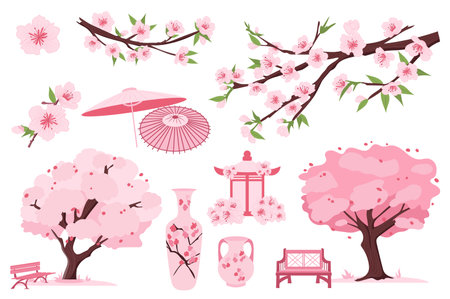Introduction to Feng Shui and British Seasonal Nuances
Feng Shui, an ancient Chinese practice, is rooted in the harmonisation of individuals with their surrounding environment. At its core, Feng Shui is concerned with the flow of energy, or “qi”, through spaces, seeking to balance the five elements—wood, fire, earth, metal, and water—to promote well-being and prosperity. While traditionally associated with Eastern interiors and philosophies, the principles of Feng Shui have found meaningful resonance within British contexts. The United Kingdom’s distinct four-season cycle—marked by brisk winters, blossoming springs, temperate summers, and crisp autumns—introduces a unique rhythm to both natural and built environments. These seasonal shifts influence not only outdoor landscapes but also internal atmospheres, impacting the way energy circulates through British homes and gardens. In adapting Feng Shui to the British climate, particular attention must be given to how seasonal changes affect spatial energy and environmental considerations. This approach encourages a more fluid interpretation of traditional Feng Shui wisdom, blending it thoughtfully with local weather patterns, daylight variations, and garden culture that are quintessentially British.
Historical Roots of Water Features in British Gardens
Water features have long played a central role in the design and atmosphere of British gardens, their presence echoing both ancient traditions and evolving aesthetic sensibilities. From the grand ponds and stately fountains of classical estates to the more recent introduction of rills and reflective pools in urban settings, water has symbolised life, prosperity, and harmony within the landscape. The British affinity for water elements can be traced back to Roman occupation, where ornamental pools and baths were first introduced. Over centuries, these influences merged with local customs, resulting in unique garden styles that integrate water as a core element.
| Era | Type of Water Feature | Cultural Significance |
|---|---|---|
| Tudor & Elizabethan | Moats, fishponds | Defence, sustenance, status |
| Georgian | Ornamental lakes, cascades | Grandeur, naturalism |
| Victorian | Fountains, rockeries | Technological progress, artistic display |
| Contemporary Urban | Rills, reflecting pools | Tranquillity, modern aesthetics |
The integration of water features into British gardens is not merely decorative but deeply tied to philosophical and spiritual beliefs. In traditional estate gardens such as those at Chatsworth or Stourhead, carefully placed ponds and winding streams were designed to reflect the shifting seasons—mirroring nature’s cycles and embodying balance. This approach aligns remarkably well with Feng Shui principles, which emphasise the importance of flowing water for channelling positive energy (Qi) throughout a space. As urbanisation has advanced, new trends have emerged: contemporary designers now favour minimalist rills or geometric pools that fit seamlessly into compact city spaces while still honouring the age-old association between water and wellbeing.

3. Seasonal Placement and Activation of Water Elements
Within the context of British seasonal Feng Shui, the successful positioning and activation of water features hinge on a sensitive understanding of both the shifting climate and the subtleties of local daylight. Each season in Britain brings its own character—whether it be the gentle optimism of spring, the languid warmth of summer, the golden tones of autumn, or the crisp clarity of winter. Water elements must therefore be adapted not only to these seasonal changes but also to regional nuances, such as Scotland’s bracing rains or the softer southern light.
Spring: Renewal and Awakening
As daylight lengthens and gardens stir back to life, spring is an ideal time for reactivating fountains or ponds that may have lain dormant during colder months. Positioning water features in sun-dappled areas—often to the east or southeast—can symbolise renewal and encourage fresh energy into the home, echoing traditional British beliefs in the restorative powers of flowing water after winter’s quietude.
Summer: Cooling Retreats
During Britain’s milder but sometimes unexpectedly hot summers, water features can provide a cooling focal point. Locally, placing a birdbath or reflective pool in partially shaded corners helps moderate temperature and humidity while attracting native wildlife. In accordance with Feng Shui principles, ensure movement—such as a gentle trickle or cascade—to keep energy vibrant but soothing, mirroring the languorous pace of long summer evenings.
Autumn: Harvest and Reflection
The arrival of autumn signals shorter days and a gradual inward turning. Water features at this time benefit from being situated where they catch afternoon sunlight, making use of lingering warmth and enhancing the golden hues characteristic of British landscapes. Consider adding subtle lighting to ponds or streams to extend their presence into dusk, aligning with both practical needs and Feng Shui’s advocacy for harmonious transitions between light and dark.
Winter: Stillness and Clarity
In winter, when natural light wanes and frost often laces garden features, still water can act as a contemplative mirror reflecting bare branches and pale skies. Traditionally in Britain, this is a time for maintenance rather than activation; however, a well-placed bowl or small indoor fountain near a south-facing window can subtly invigorate stagnant spaces without clashing with the season’s restful mood.
Local Adaptation and Sensitivity
The artful placement and timing of water feature activation must always respect local microclimates—be it coastal mists in Cornwall or highland snow in Cumbria. By weaving together British seasonal rhythms with core Feng Shui concepts, one ensures that water elements do more than decorate: they foster balance, renewal, and wellbeing throughout the year.
4. Cultural Meanings and Modern Applications
In the context of British seasonal Feng Shui, water features carry layered significance, seamlessly weaving together ancient Chinese principles with the nuances of contemporary UK living. Traditionally, water in Feng Shui symbolises prosperity, renewal, and harmonious energy flow—concepts that resonate deeply when adapted for British environments. In the UK, water also holds historical and cultural weight, from the reflective calm of estate ponds to the lively trickle of city fountains. By blending these values, modern British homes and public spaces create atmospheres that are both tranquil and invigorating.
Traditional Symbolism Meets British Identity
Water features in Britain often draw upon local motifs: garden ponds evoke the classic English landscape garden, while ornamental fountains recall Victorian grandeur. Simultaneously, these installations are positioned according to Feng Shui guidelines—such as facing east to invite spring vitality or north for career enhancement—merging aesthetic tradition with spiritual intent.
Common Symbolic Associations in the UK
| Feng Shui Element | British Interpretation | Contemporary Application |
|---|---|---|
| Flowing Water | Life’s Continuity (Rivers like the Thames) |
Garden streams to promote relaxation and connection to nature |
| Ponds & Still Water | Reflection & Contemplation (Traditional estate gardens) |
Circular ponds used for meditative spaces or biodiversity support |
| Fountains | Celebration & Community (Town squares and parks) |
Modern water sculptures serving as focal points in public spaces |
| Mist & Rain Features | Mystery & Renewal (UK weather patterns) |
Misting systems for sensory gardens and urban cooling |
Bringing Tradition into Modern British Homes
The integration of water features within a British context is not solely about aesthetics; it reflects a mindful approach to space. Homeowners increasingly select designs that honour local heritage while embracing Feng Shui’s energetic benefits. For instance, a small indoor fountain can symbolise a constant flow of opportunity during winter months when daylight wanes. Meanwhile, rainwater harvesting systems double as eco-friendly solutions and subtle nods to both sustainability and elemental harmony. Through such thoughtful combinations, British residents are able to cultivate environments that nurture wellbeing across all seasons.
5. Practical Tips for Sustainable Water Features
Incorporating water features into your British seasonal Feng Shui practice can be both aesthetically pleasing and environmentally conscious. The UK’s unique climate, with its moderate temperatures and frequent rainfall, offers opportunities for sustainable installation and maintenance. Below are some practical tips to ensure your water feature not only harmonises energy but also supports local ecology and conserves precious resources.
Eco-Friendly Installation
When planning your water feature, opt for natural materials sourced locally—such as York stone or reclaimed slate—to blend seamlessly with the British landscape. Choose solar-powered pumps wherever possible to reduce electricity consumption and carbon footprint. Positioning your feature in a spot that receives ample sunlight will maximise the effectiveness of solar energy.
Rainfall Capture and Water Conservation
The UK’s regular rainfall is an asset for maintaining water features without excessive tap water usage. Install rainwater harvesting systems—such as water butts or underground tanks—to collect and store rainwater from roofs. This harvested water can then be used to top up ponds or fountains, ensuring a sustainable supply even during drier spells. Additionally, use evaporation-minimising designs like deeper basins or shaded placements to reduce water loss.
Encouraging Local Wildlife
British gardens are havens for wildlife, and well-designed water features can enhance biodiversity. Incorporate sloping edges or shallow areas to allow safe access for birds, hedgehogs, and pollinators. Plant native aquatic species such as water forget-me-not or marsh marigold around your pond to provide food and shelter while avoiding invasive species that could disrupt local ecosystems.
Maintenance with Nature in Mind
Regularly clear debris but avoid using harsh chemicals that may harm beneficial insects or amphibians. Embrace natural filtration methods by introducing oxygenating plants like hornwort, which help keep the water clear while supporting aquatic life. In winter, consider floating a ball on the surface of ponds to prevent complete freezing and maintain airflow for fish and frogs.
A Balanced Approach
By thoughtfully integrating these sustainable strategies, you honour both the spirit of Feng Shui and the rhythms of the British seasons. A well-maintained, eco-friendly water feature can become a living symbol of harmony—nurturing positive energy while respecting the environment for generations to come.
6. Case Studies from British Homes and Public Spaces
The practical application of water features in the context of British seasonal Feng Shui can be vividly illustrated through real-life examples, both within private gardens and in public spaces across the UK. These case studies reveal not only the adaptability of water elements to Britain’s ever-changing climate but also their profound impact on well-being throughout the year.
Private Gardens: A Tranquil Retreat in Surrey
In a classic Surrey home, a modest koi pond is set amidst perennial borders. The homeowner adapts the feature with subtle lighting during winter months to offset early sunsets and enhance tranquillity, while aquatic plants are introduced in spring and summer for vibrancy and natural filtration. This seasonal approach ensures positive qi flows year-round, promoting relaxation and mindfulness for all who visit the garden.
Cotswold Courtyard Fountain
A restored Cotswold stone cottage incorporates a small wall-mounted fountain in its courtyard. By adjusting water flow rates and surrounding foliage with each season—lush ferns for summer shade, hardy evergreens for winter structure—the owners maintain harmony with nature and provide a soothing backdrop for daily life, echoing traditional Feng Shui principles tailored to local conditions.
Public Spaces: Urban Renewal in London
London’s King’s Cross Granary Square fountains serve as a striking example of communal water features enhancing urban energy. These programmable jets adapt to seasonal events: playful displays cool the area during summer, while subtle lighting transforms the space into a calming retreat during darker months. The design not only encourages community interaction but also fosters emotional well-being by integrating water’s restorative qualities into city living.
Community Garden Water Rills in Manchester
In a Manchester community garden, shallow water rills wind through herb beds and seating areas. Volunteers adjust plantings seasonally to ensure year-round visual interest and biodiversity. The gentle movement of water offers sensory stimulation and supports relaxation for visitors of all ages—an inclusive interpretation of Feng Shui that aligns with contemporary British values of accessibility and sustainability.
Together, these examples showcase how thoughtfully designed water features, adapted to Britain’s unique seasons, enrich environments and nurture well-being, affirming their enduring role in both personal sanctuaries and shared public spaces.

